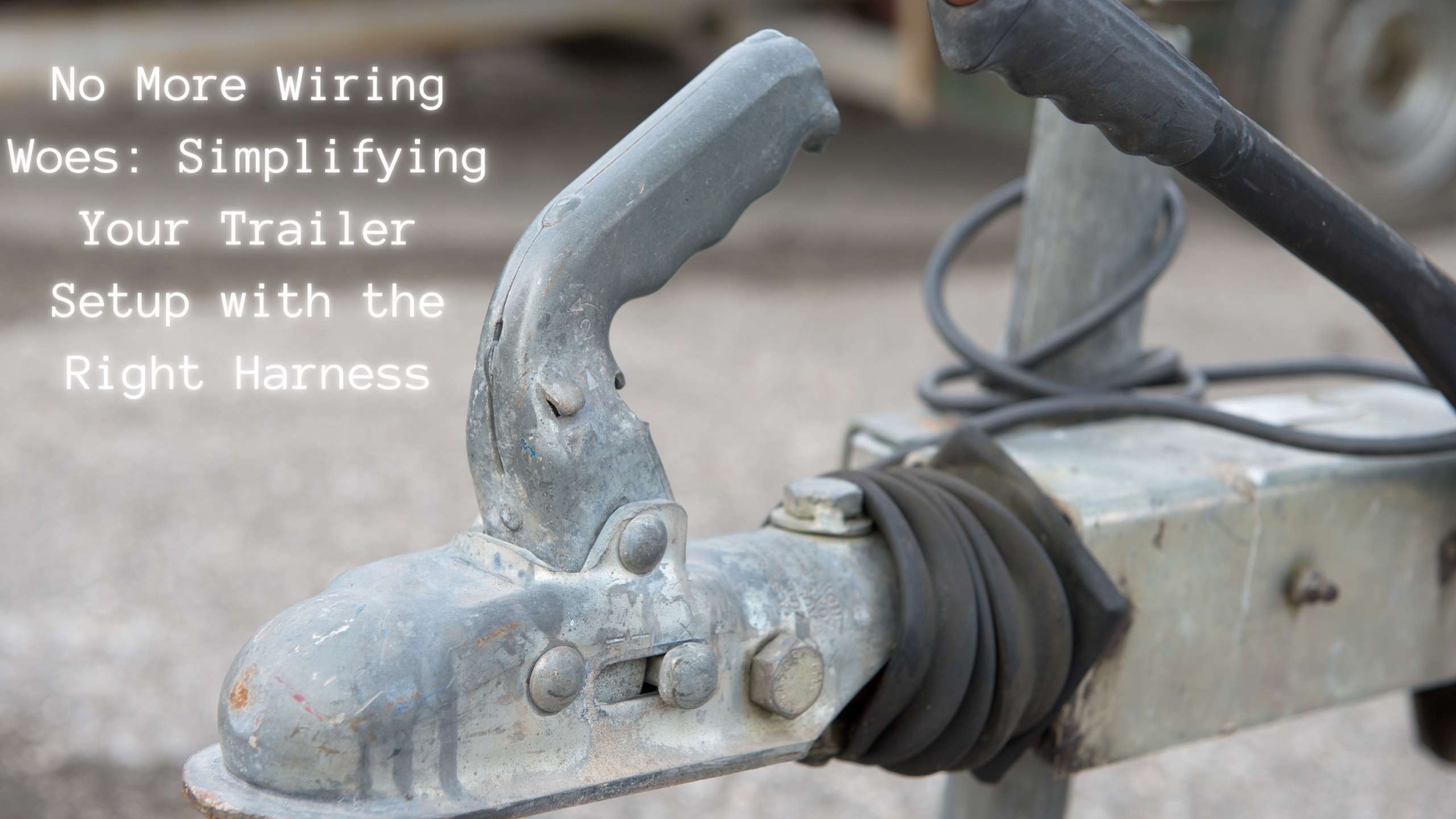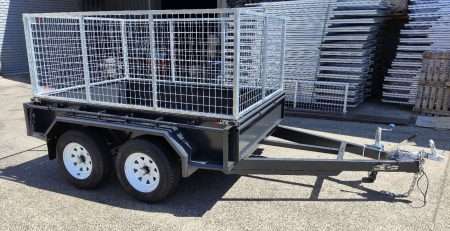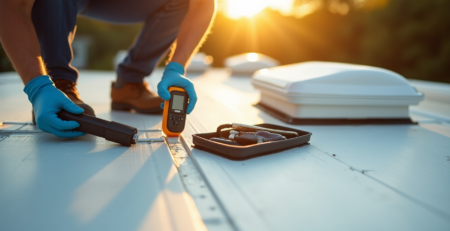
No More Wiring Woes: Simplifying Your Trailer Setup with the Right Harness
Understanding Trailer Wiring Harness
When it comes to towing, understanding the intricacies of a trailer wiring harness can make your journey smoother and safer. A trailer wiring harness is an essential component of your towing setup, ensuring that the electrical systems of your vehicle and trailer are properly linked. This section will delve into the basics of a trailer wiring harness and discuss the different types available on the market.
Basics of Trailer Wiring Harness
A trailer wiring harness provides a means of control for trailers by establishing electrical connections between vehicles and the trailers they tow. These electrical connections are crucial for the operation of lights, brakes, and other essential systems on the trailer.
In North America, brake lights and turn signals are commonly combined, particularly in the US market. This means that when a driver applies the brakes or activates the turn signal on the towing vehicle, these signals are transmitted via the trailer wiring harness to the corresponding systems on the trailer, ensuring synchronised operation and safe towing (Wikipedia).
Different Types of Wiring Harness
There are multiple standards for trailer connectors in North America, each designed for different types of vehicles and trailers.
- SAE J560 Connector: This type of connector is commonly used on heavy-duty trucks and trailers with pneumatic brakes. The SAE J560 connector does not control the brakes directly but is mainly used for power to the ABS unit and indication of braking by brake light signal. The brakes themselves are controlled using air pressure (Wikipedia).
- ISO 1185 Connector: Heavy vehicles in North America also use the ISO 1185 connector, which is similar to the SAE J560 connector but follows international standards.
- Converters: For those who need to connect a car with European wiring to a trailer with North American wiring, there are special converters available on the market. These converters combine the turn signals and stop lamp signals from a three-wire solution into a two-wire solution according to DIN standards.
Understanding the different types of wiring harnesses and their functionalities can help you select the right harness for your vehicle and trailer, ensuring a safe and efficient towing experience. In the next sections, we will discuss how to choose, install, troubleshoot, and maintain your trailer wiring harness. Be sure to check out our other accessories, like trailer brake controllers and hitch receivers for a complete towing setup.
Choosing the Right Wiring Harness
Selecting the appropriate wiring harness for your trailer setup is crucial for the safe and efficient operation of the trailer’s electrical components. The harness’s compatibility with your vehicle and trailer is one of many factors that affects this choice.
Factors to consider
When choosing a trailer wiring harness, consider the following factors:
- Type of Trailer: Different types of trailers require different types of plugs. For instance, boat trailers without surge brakes frequently use 4-way flat plugs, while camper trailers generally come with 7-way RV blade plugs (LinkedIn).
- Vehicle’s Wiring System: Vehicles utilise different wiring systems, including two-wire systems, three-wire systems, and pulse width modulation (PWM) systems. These systems differ in the number of wires used to transmit stop, turn, and tail signals.
- Additional Towing Accessories: If you’re using additional towing accessories like a trailer brake controller or electric winch, ensure the wiring harness is capable of supporting these components.
- Installation: Consider how the wiring harness will be installed. Some harnesses are plug-and-play, while others may require professional installation.
- Durability: The wiring harness should be durable and able to withstand harsh weather conditions. It should also be resistant to wear and tear from regular use.
Compatibilities with Vehicles and Trailers
The wiring harness should be compatible with both your vehicle and trailer. To ensure this compatibility, you may need to use an adapter. Adapters act as a bridge between two different connector types and do not require any extra work to establish the connection (LinkedIn).
Moreover, a custom trailer wiring harness, also known as a T-connector, provides a socket to connect to the trailer using a 4-way flat. The need for an integrated converter will depend on the vehicle’s requirements.
By considering these factors and ensuring compatibility between your vehicle and trailer, you can select the most suitable wiring harness for your towing needs. Remember, the right harness will not only simplify your trailer setup, but it will also make your towing journey safer and more efficient.
Installation of Trailer Wiring Harness
Understanding how to install a trailer wiring harness is a key skill for anyone who frequently tows a trailer. This process ensures safety and compliance with traffic laws, making towing easier and more convenient. The installation process is relatively straightforward and can be done with basic tools and electrical knowledge.
Pre-installation Preparations
Before beginning the installation of your trailer wiring harness, it’s important to ensure that the harness matches the towing vehicle’s wiring system. This is crucial for the harness to function properly with the vehicle.
Trailer wiring harnesses come in various types, such as 4-way flat connectors, 5-way flat connectors, and 7-way round connectors, each compatible with different trailer wiring systems. Determine the type of connector that suits your trailer and vehicle wiring systems before proceeding with the installation (U-Haul).
Steps for Installation
Once you’ve selected the appropriate trailer wiring harness, you’re ready to start the installation process. Here are the general steps that apply to most harness types:
- Locate the vehicle’s tail light wiring harness, typically found behind the vehicle’s tail lights.
- Connect the trailer wiring harness to the vehicle’s wiring harness. Ensure that the colour codes on both harnesses match.
- Run the harness along the frame of the vehicle and towards the hitch receiver. Secure the harness with zip ties or electrical tape to prevent it from hanging loose.
- Mount the connector to the rear bumper. Ensure that it is easily accessible and protected from road debris.
- Test the harness by connecting it to the trailer and turning on the vehicle’s lights.
Remember, these are general steps and the exact process might vary based on the specific type of harness and vehicle. Installing a 4-pin trailer wiring harness, for example, typically involves connecting the harness to the vehicle’s existing wiring system and mounting the connector to the rear bumper (Piloteers.org).
By correctly installing your trailer wiring harness, you’ll ensure a safe and convenient towing experience. For further assistance with your towing needs, explore our range of products, such as trailer brake controllers, hitch receivers, and trailer light kits.
Troubleshooting Trailer Wiring Harness
Despite all the precautions and care, there may still be situations where a trailer wiring harness encounters issues. This section addresses some of the common problems that can arise and provides a guide on how to troubleshoot these issues.
Common Issues and Causes
A common cause of trailer wiring issues is a faulty or worn-out trailer wiring harness. This can result in problems with brake lights, turn signals, and running lights. Trailer Superstore. One frequent issue with trailer wiring harnesses is a malfunctioning ground connection, which can cause the lights on the trailer to not function properly. It is important to ensure that the ground connection is secure and free of corrosion.
| Common Issues | Causes |
|---|---|
| Brake lights are not working. | Faulty or worn-out trailer wiring harness |
| Turn signals are not functioning. | Damaged ground connection |
| Running lights are not illuminating. | Corroded connections |
Steps for Troubleshooting
Troubleshooting a trailer wiring harness involves several steps. Initially, check the connections for corrosion or damage, and use a circuit tester to ensure power is flowing through the harness. It’s also important to examine the fuses and relays in the towing vehicle on etrailer.com.
If the trailer wiring harness is damaged beyond repair, it may be necessary to replace it. This can be done by purchasing a new harness and following the installation instructions provided on etrailer.com.
In some cases, troubleshooting trailer wiring harnesses may require checking the vehicle’s wiring system, such as the fuse box and relays, to ensure they are functioning properly.
| Steps for Troubleshooting | Description |
|---|---|
| Check the connections. | Inspect for corrosion or damage. |
| Test the harness. | Use a circuit tester to ensure power flow. |
| Examine fuses and relays. | Ensure they are functioning properly. |
| Replace the faulty harness. | If the harness is damaged beyond repair, |
For more information on related topics, check out our articles on trailer brake controllers, trailer hitch locks, and trailer light kits.
Maintaining Your Wiring Harness
Maintaining your trailer wiring harness is crucial to ensuring safe and efficient towing. Regular inspection and care can help prevent common issues related to faulty or worn-out harnesses, such as problems with brake lights, turn signals, and running lights.
Regular Inspection Tips
Regular inspection of your trailer wiring harness can help identify any potential issues before they cause a problem. Here are a few tips for performing a thorough check:
- Look for any signs of physical damage. Frayed wires, loose connections, or damage to the protective sleeve are all indicators that the harness may need to be replaced.
- Check the connectors. Ensure that all connectors are clean and free of corrosion. Dirty or corroded connectors can result in poor electrical conductivity.
- Test all lights and signals: Connect the harness to your vehicle and make sure that all lights and signals on the trailer are functioning correctly.
If any issues are found during your inspection, it’s important to resolve them immediately. This may involve replacing the wiring harness with a new one that is compatible with your trailer and vehicle.
Prevention and care
In addition to regular inspections, proper care and maintenance can help prolong the life of your trailer wiring harness. Here are some preventive measures to consider:
- Protect the harness from the elements: Whenever possible, store your trailer in a covered area to protect the wiring harness from rain, snow, and excessive heat or cold.
- Keep the connectors clean. Regularly clean the connectors to prevent corrosion.
- Avoid unnecessary strain: Be careful not to pull or tug on the wiring harness. This can cause the wires to become loose or damaged.
By taking these steps, you can ensure that your trailer wiring harness remains in good working condition for many years to come. For more information on installing and troubleshooting a wiring harness, check out our articles on trailer brake controllers and trailer light kits.
Customising Your Wiring Harness
While standard trailer wiring harnesses can meet most towing needs, there might be instances where you want to customise your wiring setup to better suit your specific requirements. Customising a trailer wiring harness allows you to tailor the wiring system to your vehicle’s and trailer’s unique needs.
Benefits of Custom Wiring
A custom trailer wiring harness, also known as a T-connector, provides a socket to connect to the trailer using a 4-way flat (LinkedIn). This setup offers several benefits.
Firstly, it allows for precise compatibility with your vehicle’s wiring system. This ensures that the electrical connection between your vehicle and trailer is seamless, reducing the risk of electrical issues while towing.
Secondly, a custom wiring harness may or may not require an integrated converter, depending on the vehicle’s requirements. An electric converter is used when the vehicle and trailer have different wiring systems, allowing for the connection of complex vehicle wiring with simple trailer wiring.
Lastly, custom wiring allows for the inclusion of specific plugs and sockets that match the type of trailer you are towing, whether it’s a boat trailer, utility trailer, camper trailer, 5th wheel trailer, or gooseneck trailer. This ensures a secure and reliable connection for safe towing.
The Process of Customisation
The process of customising a trailer wiring harness involves a few steps and can be done with a few tools and a trailer wiring harness.
- Removal of Old Wiring: Start by removing any existing wiring. This may involve disconnecting and removing old harnesses, plugs, and sockets.
- Cleaning: Once the old wiring is removed, clean the area to prepare it for the new wiring. This helps to ensure a good connection and reduces the risk of electrical issues.
- Routeing the New Wiring: Route the new custom wiring harness through the vehicle to the trailer hitch. This should be done in a way that avoids sharp edges and hot or moving parts.
- Connecting the Ground Wire: Connect the ground wire to a suitable grounding point on the vehicle.
- Installing the lights: Connect the wiring to the trailer light kit. This will involve connecting the wires for the tail lights, brake lights, and turn signals.
- Testing the Connection: Finally, test the connection to ensure that all the lights are working correctly. This can be done by turning on the vehicle’s lights and checking the trailer lights, or by using a trailer light tester.
The customisation of a trailer wiring harness allows for a precise and secure electrical connection between your vehicle and trailer. Whether you’re towing a boat with a boat trailer winch or an ATV with an ATV winch, a custom wiring harness can ensure a safe and successful towing experience.
Author
I am Rahatul Ashiq Tamal. Another author of Muscle Trailers. Muscle Trailers is a well-known trailer brand in Sydney, Melbourne & Adelaide

How to Mount a Spare Tire on Your Trailer: A Simple Step-by-Step Guide
Trailer service centers receive over 1 million phone calls and 1.3 million emails each year about trailer maintenance problems....

How to Fix RV Roof Leaks: Simple Roof Leak Detection Guide for Beginners
Did you know DIY RV roof repairs can cost under $50? But undetected leaks could lead to substantially higher repair...

Starting a Food Truck Business in Australia: From Trailer Selection to Launch
The Australian mobile food market has evolved into a billion-dollar industry. This makes a food truck...
